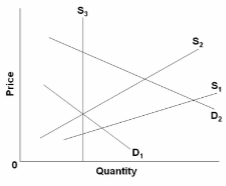The diagram concerns supply adjustments to an increase in demand (D 1 to D 2 ) in the immediate market period, the short run, and the long run. In the immediate market period, the increase in demand will:

A. have no effect on either equilibrium price or quantity.
B. increase equilibrium price but not equilibrium quantity.
C. increase equilibrium quantity but not equilibrium price.
D. increase both equilibrium price and quantity.
Ans: B. increase equilibrium price but not equilibrium quantity.
You might also like to view...
Your local grocery store offers a coupon that reduces the price of milk during the coming week. The regular retail price of milk in the store is $3.00 per gallon, and the coupon price is $2.00 per gallon for the next week
If the store maximizes profits and the price elasticity of demand for milk is -2 for coupon users, what is the price elasticity of demand for non-users? A) -0.67 B) -1.0 C) -1.5 D) We do not have enough information to answer the question.
When interest rates in the U.S. decrease, we can expect NCO to:
A. decrease, because capital inflow is increasing. B. increase, because capital inflow is decreasing. C. decrease, because capital inflow is decreasing. D. increase, because capital inflow is increasing.
Scarcity is a concept that does not apply to
A. human wants. B. natural resources. C. land. D. machinery.
Draw the demand curve for a good whose price elasticity of demand is equal to infinity. Be sure to label both axes.
What will be an ideal response?